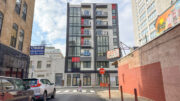In the 1940s, development in Philadelphia progressed at a slow pace as over the previous four years the United States of America was engaged in World War II after Japan’s surprise attack on Pear Harbor on December 7, 1941, further slowed down by the Great Depression, which lasted through the 1930s. However, in the preceding decades, many ornate buildings rose into the skyline with fantastic masonry designs. Most of the largest buildings were built around the City Hall in Center City, which created a hub of development when the Second Empire style building was completed in 1901.

Philadelphia 1945 aerial looking east. Models and image by Thomas Koloski

Philadelphia 1945 top view. Models and image by Thomas Koloski
City Hall, topped by the William Penn statue, was one of the oldest developments that formed high-rise canyons around the area, primarily along Market Street and Broad Street, which converge at the building. One structure that does not stick out in the skyline, yet still has a massive presence is the so-called “Chinese Wall” that took up several blocks and ran west from City Hall to the Schuylkill River. The elevated rail line split Center City in half as it rose approximately 30 feet above the street.

Philadelphia 1945 looking northwest. Models and image by Thomas Koloski

Philadelphia 1945 looking north. Models and image by Thomas Koloski

Philadelphia 1945 looking south. Models and image by Thomas Koloski
The largest skyscraper in the visuals is the PSFS Building, which, as you may have noticed, does not yet feature the 301-foot-tall antenna at the top, as it was erected three years later in 1948. At the time, the tower stood 491 feet high, with the PSFS signs illuminated with neon, lighting up the skyline at night. Another building that does not feature its tall antenna is the Architects Building, which had its antenna installed some time in the 1950s. The Girard Trust Building, which was completed in 1931, is prominently visible to the south of City Hall, along with One East Penn Square, which was recently constructed to the east of City Hall.
Subscribe to YIMBY’s daily e-mail
Follow YIMBYgram for real-time photo updates
Like YIMBY on Facebook
Follow YIMBY’s Twitter for the latest in YIMBYnews






If you look at Market Street from City Hall westward, you will not only see the Chinese wall, but will see the egress bridge for both the Market Frankford EL and trolleys sharing a bridge across the Schuylkill River until the El went along its elevated railway to 32 street elevated station and onwards to a string of elevated stations until hitting 69th street at the end.
The City had started construction on the westward subway tube in the 1920s until work was halted by the Great Depression and further delayed by WWII. Only after the war was over was construction ŕesuned on extending the subway
tube from 15th Street to 4th Street Station when the trains exited the tube to the elevated station at 46th street.
The City never completed further extension of the subway to 69th street because engineers could not figure how to put a tunnel underneath a river.
Correction -extending subway tube from 15th Street to 4th Street subway station …
Amazing how much the city has changed in only 75 years; I know a lot of people who remember when Philadelphia looked like this. The views of Philadelphia you see here is what Philadelphia looked like at the end of World War II; American as well as some French sailors would have seen this skyline. When you compare Philadelphia now to then it looks so different.